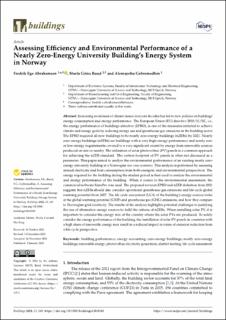| dc.contributor.author | Abrahamsen, Fredrik Ege | |
| dc.contributor.author | Ruud, Sturla Grina | |
| dc.contributor.author | Gebremedhin, Alemayehu | |
| dc.date.accessioned | 2023-10-26T13:10:05Z | |
| dc.date.available | 2023-10-26T13:10:05Z | |
| dc.date.created | 2023-03-06T08:51:05Z | |
| dc.date.issued | 2023 | |
| dc.identifier.citation | Buildings. 2023, 13 (1), . | en_US |
| dc.identifier.issn | 2075-5309 | |
| dc.identifier.uri | https://hdl.handle.net/11250/3098970 | |
| dc.description.abstract | Increasing awareness of climate issues in recent decades has led to new policies on buildings’ energy consumption and energy performance. The European Union (EU) directive 2010/31/EC, i.e., the energy performance of buildings directive (EPBD), is one of the measures initiated to achieve climate and energy goals by reducing energy use and greenhouse gas emissions in the building sector. The EPBD required all new buildings to be nearly zero-energy buildings (nZEBs) by 2021. Nearly zero-energy buildings (nZEBs) are buildings with a very-high-energy performance and nearly zero or low-energy requirements covered to a very significant extent by energy from renewable sources produced on-site or nearby. The utilisation of solar photovoltaic (PV) panels is a common approach for achieving the nZEB standard. The carbon footprint of PV panels is often not discussed as a parameter. This paper aimed to analyse the environmental performance of an existing nearly zero-energy university building in a Norwegian use case scenario. This analysis is performed by assessing annual electricity and heat consumption from both energetic and environmental perspectives. The energy required for the building during the studied period is then used to analyse the environmental and energy performance of the building. When it comes to the environmental assessment, the commercial software SimaPro was used. The proposed revision EPBD and nZEB definition from 2021 suggests that nZEBs should also consider operational greenhouse gas emissions and life-cycle global warming potential from 2027. The life cycle assessment (LCA) of the building’s energy sources looks at the global warming potential (GWP) and greenhouse gas (GHG) emissions, and how they compare to Norwegian grid electricity. The results of the analysis highlights potential challenges to justifying the use of alternative energy sources to fulfil the criteria of nZEBs. When installing solar PV, it is important to consider the energy mix of the country where the solar PVs are produced. To solely consider the energy performance of the building, the installation of solar PV panels in countries with a high share of renewable energy may result in a reduced impact in terms of emission reduction from a life cycle perspective. | en_US |
| dc.language.iso | eng | en_US |
| dc.publisher | MDPI | en_US |
| dc.rights | Navngivelse 4.0 Internasjonal | * |
| dc.rights.uri | http://creativecommons.org/licenses/by/4.0/deed.no | * |
| dc.title | Assessing Efficiency and Environmental Performance of a Nearly Zero-Energy University Building’s Energy System in Norway | en_US |
| dc.title.alternative | Assessing Efficiency and Environmental Performance of a Nearly Zero-Energy University Building’s Energy System in Norway | en_US |
| dc.type | Peer reviewed | en_US |
| dc.type | Journal article | en_US |
| dc.description.version | publishedVersion | en_US |
| dc.source.pagenumber | 0 | en_US |
| dc.source.volume | 13 | en_US |
| dc.source.journal | Buildings | en_US |
| dc.source.issue | 1 | en_US |
| dc.identifier.doi | 10.3390/buildings13010169 | |
| dc.identifier.cristin | 2131381 | |
| cristin.ispublished | true | |
| cristin.fulltext | original | |
| cristin.qualitycode | 1 | |

